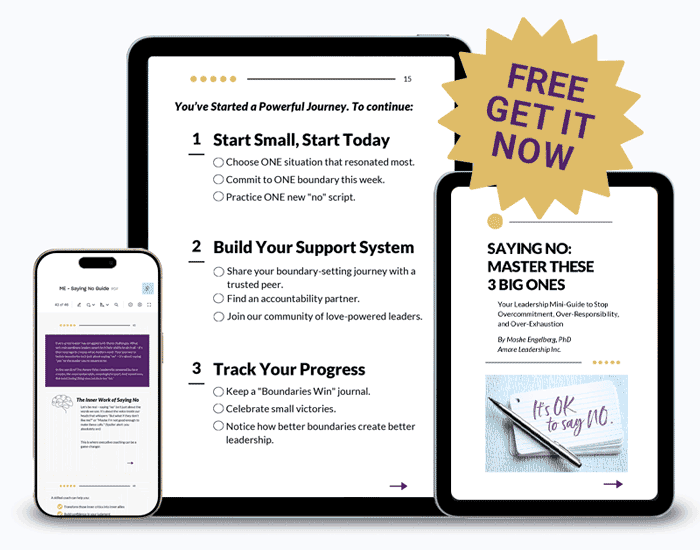How can we help each other succeed? It’s a deceptively simple question—and one of the most powerful tools you have as a CEO.
Imagine introducing a practice where you and your senior leaders each identify one specific, observable behavior to improve about yourselves – concrete actions like “end every meeting with agreed next steps” or “pause before responding to tough questions” – chosen by blending what matters most to you with what your colleagues say would make the biggest difference for them.
Set the Tone at the Top
When you, as CEO, go first—inviting feedback, listening without defensiveness, and adding your own insight to the mix—you give your team permission to do the same. This is the essence of stakeholder-centered coaching, a process pioneered by Marshall Goldsmith and colleagues: combining external feedback from those affected by your leadership with your own internal clarity about what matters most right now. That combination produces goals that are both meaningful and doable.
Build a Feedback-Friendly Culture
Once you’ve set your personal focus, share it openly and ask a few people to watch for it in action. Follow up periodically, with check-in statements like this “I’ve been working on my communication—what are you noticing about it?”
These brief exchanges keep the process alive and send a clear signal: progress matters, feedback is welcome, and everyone is accountable for their own growth. Over time, this becomes less “CEO’s latest project” and more “just how we do things here”—a habit of learning with real accountability.
- What’s your first response to the idea of getting and giving behavioral feedback being a routine part of your culture?
- What one behavior rises to the top when you combine your own self-assessment with feedback from others?
- How will you model this practice so your team feels safe and inspired to do the same?
Quick Favor!
I’m kicking off a new Amare Leadership book series based on these newsletters and want your input. Which of these topics should I write first? Contact me here and send me the number(s) you like best.
1. Real Love at Work — Why being “too nice” fails your team and what to do instead.
2. Inner Strength — Stay centered and take inspired action when work gets stressful.
3. Authentically YOU — Really showing up for your people as the best version of yourself.
4. Clarity — Cutting through the noise and busy-ness to get focused and build trust.
5. Fun Factor — Making joy a serious and sustainable leadership strategy.
6. Hard Conversations — Turning tough talks into moments of truth and trust.
7. Sparking Change — Inspire your team to be their best by leading with love.
Your vote will help shape the very first book in the series!
7 Amare Action Steps for You and Your Leadership Team
1. Ask and reflect. Gather quick input from 3–5 colleagues on one behavior you can improve, then weigh it alongside your own priorities and the organization’s needs and performance review initiatives.
2. Make it public. Share your chosen focus with your team so they can notice and support your progress.
3. Check progress regularly. Once or twice a month, ask those same colleagues what they’ve observed and thank them for their input.
4. Coach your team to do the same. Walk each senior leader through the process—help them identify their behavior, seek input, and set a check-in plan.
5. Embed into leadership meetings. Start monthly leadership meetings with a 5-minute “what I’m working on” round, keeping it light but consistent.
6. Pair people up. Encourage leaders to choose an “accountability buddy” who will observe their shift and give real-time feedback.
7. Capture and share wins. Create a shared document or quick Slack channel where leaders can post “small wins” and what they’ve noticed about themselves or others.
A Core Leadership Practice
As CEO, your behavior sets the tone inside your company. By modeling a clear, consistent cycle of input, reflection, action, and follow-up to improve behaviors in yourself, you create a culture where feedback is normal and growth is expected.
When leaders at every level see you doing this—choosing your own focus, asking for input, acting on it, and looping back—they’re far more likely to follow suit. Over time, the practice becomes part of your organization’s DNA, making it more adaptive, more connected, and more effective. All because you started with one well-chosen behavior, the courage to work on it in the open, and the willingness to invite your team to join you.
Show the way!
Moshe
Today’s Amare Wave Wednesday Quote
“Feedback is the breakfast of champions.”
— Popularized by Ken Blanchard, originally stated by Rick Tate, a leadership consultant and author
Click here and read more Amare Wave Wednesday newsletters on related topics:
How to Handle Bad Behavior Before It Turns Into a Bigger Problem
Leadership Lessons From Vital Farms’ Stakeholder-Centric Success
How CEOs Can Avoid Being the Problem Solver for Every Team Conflict
Embracing Openness and Love in Leadership: CEO Alan Mulally’s Path to “Working Together” Success
The Power of Both: How Efficiency Plus Connection Drives Leadership Success
Original article published on Inc.com.


